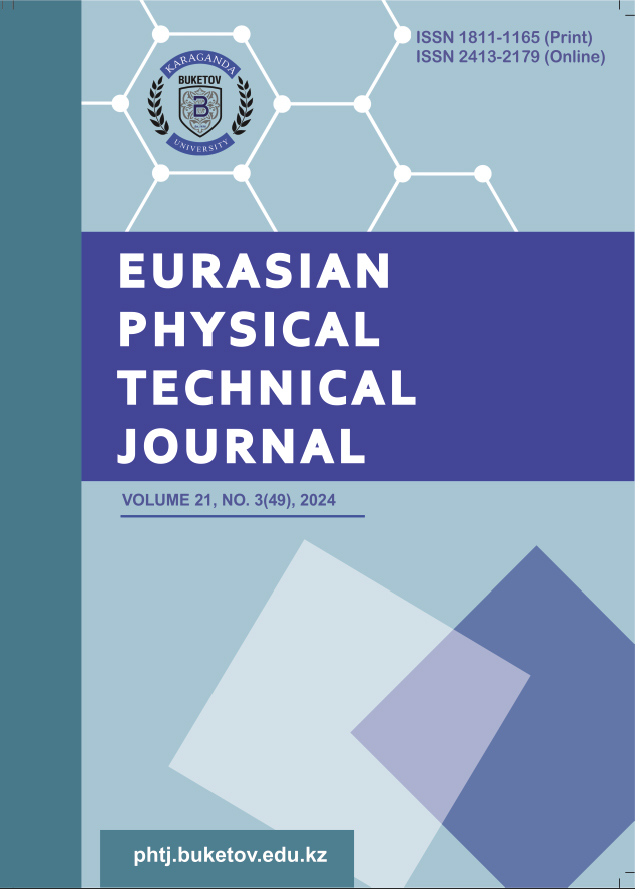INFLUENCE OF MOISTURE CONDITION AND SILICA SAND ON FRICTION COEFFICIENT OF WIND TURBINE BRAKE SYSTEM
DOI:
https://doi.org/10.31489/2024No3/117-124Keywords:
wind turbines, moisture condition, silica sand, friction coefficientAbstract
Major drive train parts for the horizontal wind turbines including the gearbox, generator, and brake system have very high repair and replacement costs and take a long time to complete. This paper investigates the impact of environmental air pollution on drivetrain tribology behaviors. Experimental research of the wind turbine's drive train system is simulated and investigated. The mechanical brake system of wind turbines is the subject of one case study chosen for this research paper. This research paper is examined how impurities affect the friction coefficient of the brake on wind turbines. According to the findings, the friction coefficient rises with each increase in wind turbine shaft speed. Also, it has been discovered that the size of the contaminants' particles significantly affects the friction coefficient. Furthermore, the findings may offer helpful insights of the drive train system that as humidity increased from 30 mm3 to 90 mm3, the coefficient of friction significantly decreased.
References
Alsyouf I., El-Thalji I. (2008) Maintenance practise in wind power systems: a review and analysis. Proceeding of the European Wind Energy Conference and Exhibition, Brussels, Belgium, 2588 – 2597. https://www.proceedings.com/content/005/005469webtoc.pdf.
Staino A., Basu B. (2013) Dynamics and control of vibrations in wind turbines with variable rotor speed. Enginnering Structures, 58 – 67. DOI: 10.1016/j.engstruct.2013.03.014.
Belhocine A., Ghazaly N.M. (2015) Effects of Material Properties on Generation of Brake Squeal Noise Using Finite Element Method. Latin American Journal of Solids and Structures, 12, 2 (8). DOI:10.1590/1679-78251520.
Babu B.C., Mohanty K.B. (2010) Doubly-fed induction generator for variable speed wind energy conversion systems–modeling and simulation. Int. J. Comput. Electr. Eng., 2(1), 141–147. DOI:10.7763/IJCEE.2010.V2.127.
Bhutta M.M.A., Hayat N., Farooq A.U., Ali Z., Jamil S.R., Hussain Z. (2012) Vertical axis wind turbine–A review of various configurations and design techniques. Renewable and Sustainable Energy Reviews, 16(4), 1926-1939. DOI: 10.1016/j.rser.2011.12.004.
Lu B., Li Y., Wu X., Yang Z. (2009) A review of recent advances in wind turbine condition monitoring and fault diagnosis. IEEE Power Electron. Mach. Wind Appl., 1–7. DOI:10.1109/PEMWA.2009.5208325.
Chellaganesh Durai, M. Adam Khan, J. T. Winowlin Jappes, Nouby M. Ghazaly, P. Madindwa Mashinini (2021) Solid particle erosion studies on thermally deposited alumina– titania coatings over aluminium alloy. International Journal of Minerals, Metallurgy and Materials, 28, 1186–1193. DOI:10.1007/s12613-020-2099-8.
Gasch R., Twele J. (2012) Wind Power Plants - Fundamentals, Design, Construction and Operation, Springer. DOI:10.1007/978-3-642-22938-1.
Yu G., Shen X., Zhu X., Du X.Z. (2011) An insight into the separate flow and stall delay for hawt, Renew. Energy, 36 (1), 69–76. DOI: 10.1016/j.renene.2010.05.021.
Howell R., Qin N., Edwards J., Durrani N. (2010) Wind tunnel and numerical study of a small vertical axis wind turbine. Renewable energy, 35(2), 412-422. DOI:10.1016/j.renene.2009.07.025.
Islam M.R., Mekhilef S., Saidur R. (2013) Progress and recent trends of wind energy technology. Renew. Sustain. Energy Rev. Renewable and Sustainable Energy Reviews, 21, 456 – 468. DOI:10.1016/j.rser.2013.01.007.
Borum K.K., McGugan M., Brøndsted P. (2006) Condition monitoring of wind turbine blades. Proc. of the 27th Risøe Intern. Symposium on Materials Science. Polymer Composite Materials for Wind Power Turbines, 139–145. http://www.risoe.dk/rispubl/AFM/sympsale.htm
Leung D.Y., Yang Y. (2012) Wind energy development and its environmental impact: a review. Renewable and Sustainable Energy Reviews, 16(1), 1031-1039. DOI: 10.1016/j.rser.2011.09.024.
Maalawi K.Y., Badr M.A. (2003) A practical approach for selecting optimum wind rotors. Renewable Energy, 28, 803–822. DOI:10.1016/S0960-1481(02)00028-9.
Ragheb M., Ragheb A.M. (2011) Wind Turbines Theory - The Betz Equation and Optimal Rotor Tip Speed Ratio. Fundam. Adv. Top. Wind Power, 1(1). DOI:10.5772/21398.
Nadica Stojanovic, Ghazaly N.M., Grujic I., Doric J. (2022) Determination of Noise Caused by Ventilated Brake Disc with Respect to the Rib Shape and Material Properties Using Taguchi Method. Transactions of FAMENA, 46 (4). DOI:10.21278/TOF.464011219.
Guo P., Infield D. (2012) Wind turbine tower vibration modelling and monitoring by the non-linear state estimation technique. Energies, 5(12), 5279 – 5293. DOI:10.3390/en5125279.
Sun Q., Chen C., Zhang D., Xi F. (2020) Pattern recognition for automatic machinery fault diagnosis,” Mechanical Systems and Signal Processing, 142, 106680. DOI:10.1016/j.ymssp.2020.106680.
Randall R.B., Antoni J. (2011) Rolling element bearing diagnostics—A tutorial, Mechanical Systems and Signal Processing. 25, 2, 485 – 520. DOI:10.1016/j.ymssp.2010.07.017.
Peng H., Li S., Shangguan L., Fan Y., Zhang H. (2023) Analysis of Wind Turbine Equipment Failure and Intelligent Operation and Maintenance Research. Sustainability, 15(10), 8333. DOI:10.3390/su15108333.
Roman A., Lemos, G.V.B., Gasparin A.L. (2022) Friction material wear: Effects and interactions between service brake temperature, lining contact pressure, and vehicle speed. Proceedings of the Institution of Mechanical Engineers, Part J: Journal of Engineering Tribology, 236(12), 2468 – 2476. DOI:10.1177/13506501221080282.
Roy S., Saha U.K. (2015) Wind tunnel experiments of a newly developed two-bladed Savonius-style wind turbine. Appl Energy.,137, 117–125. DOI:10.1016/j.apenergy.2014.10.022.
Jens N.S. (2011) Wind Energy Systems: Optimising Design and Construction for Safe and Reliable Operation. Woodhead Publishing, DOI:10.1533/9781857090638.
Amirat Y., Benbouzid M.E.H., Bensaker B., Wamkeue R. (2007) Condition Monitoring and ault Diagnosis in Wind Energy Conversion Systems: A Review in Electric Machines and Drives Conference. IEMDC ‘07, IEEE International. DOI:10.1109/IEMDC.2007.383639.
Zhang M.X., Ou Y.D., Yuan H.B., Pan J.L., Ma L. (2023) Simulation experiment study on friction and wear of materials under high humidity conditions. Industrial Lubrication and Tribology, 75, 6, 672 – 678. DOI:10.1108/ILT-04-2023-0090.
Downloads
Received
Revised
Accepted
Published online
How to Cite
Issue
Section
License

This work is licensed under a Creative Commons Attribution-NonCommercial-NoDerivatives 4.0 International License.













